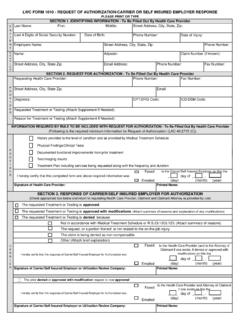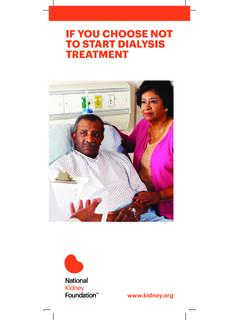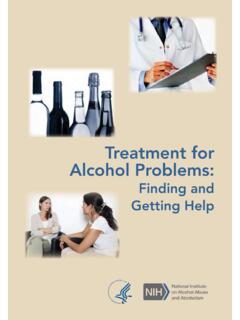Transcription of The DISCERN Handbook
1 TheDISCERNH andbookQuality criteria for consumer health informationon treatment choicesCompiled byDeborah CharnockRadcliffe Medical Press 1998 University of Oxford and The British LibraryRadcliffe Medical Press Ltd18 Marcham Road, Abingdon, Oxon OX14 1 AAAll rights reserved. No part of this publication may be reproduced, stored in a retrieval system or transmitted, in anyform or by any means, electronic, mechanical, photocopying, recorded or otherwise without the prior permission of thecopyright individuals, organisations and publishers involved in The DISCERN Handbook accept no responsibility for claimsresulting from its improper Library Cataloguing in Publication DataA catalogue record for this book is available from The British 1 85775 310 0 Typeset by Advance Typesetting Limited.
2 And bound in Great BritainTheDISCERN Project Team consisted of:Sasha Shepperd(Project Manager), Research Officer, Division of PublicHealth and Primary Care, University of OxfordDeborah Charnock, Research Officer, Health Services Research Unit,Division of Public Health and Primary Care, University of OxfordGill Needham, Research and Development Specialist, BuckinghamshireHealth Authority, AylesburyRobert Gann, Director, The Help for Health Trust, WinchesterDISCERN was developed by an Expert Panel consisting of:Clinical specialistsIan Arnold, Cardiology Department, Horton General Hospital, BanburyStephen Kennedy, Nuffield Department of Obstetrics and Gynaecology,John Radcliffe Hospital, OxfordMichael Sharpe, University Department of Psychiatry, Royal EdinburghInfirmary, EdinburghSelf-help group representativesIan Barratt, Action for ME, Banbury GroupSusan Gould, National Endometriosis Society, Reading GroupDavid Pope, Heartbeat Club, John Radcliffe Hospital, OxfordGeneral practitionersRoger Pietroni, LondonCecilia Pyper.
3 OxfordConsumer health information expertHelen Thompson, Trent Healthline, NottinghamLay medical publisherSusan Harrison, Science Publications, Oxford University PressThe DISCERN HandbookiiiHealth journalistAnnabelle May, LondonHealth consumerSandy Oliver, Ashstead, SurreyCommunity Health Council representativeClaire Laurent, OxfordPlain English Campaign representativeJames Middleton, Whaley BridgeNHS Centre for Reviews and Dissemination RepresentativeVikki Entwhistle, YorkThe DISCERN Project was funded by The British Library and the NHS Research & Development ProgrammeivThe DISCERN HandbookContentsPrefaceviiIntroduction1 List of terms3 Part 1: Background5 Part 2: General instructions9 Part 3: Instructions for rating each question13 Part 4: The DISCERN instrument43 Part 5: Quick reference guide to the DISCERN criteria51 Evaluation53 PrefaceDespite a growing investment in consumer health information , the quality ofinformation remains variable.
4 The DISCERN instrument has been developed inrecognition of the need for a general set of quality criteria for written consumerhealth information on treatment choices. DISCERN will enable consumers andinformation providers to judge the quality of such information . DISCERN can also be used by authors and producers as a guide to the standard of information on treatment choices which consumers are entitled to DISCERN Handbookhas been developed to ensure that all DISCERN users are able to understand and apply the instrument effectively. The Handbook is also a useful resource for education and training among professional and consumergroups on the issues of health information quality, shared decision-making andevidence-based consumer arose from a national project to establish quality thresholds for writteninformation on treatment choices provided by NHS organisations, charities andself-help groups, the pharmaceutical industry and other sources of consumer healthinformation.
5 As the demand for information continues to increase, DISCERN willplay a vital role in the delivery of effective healthcare by ensuring that consumersare able to make informed treatment choices based on good evidence. The researchteam, expert panel and all involved in the development of DISCERN hope it willenable those who use or supply consumer health information to achieve thisimportant Project TeamJune 1998 IntroductionDISCERN has been designed to help health consumers and information providersassess the quality of written information about treatment choices for a healthproblem.
6 Although it is unlikely that any one publication can meet all theinformation needs of a health consumer, there are certain features which should be present if the publication is to be considered useful and appropriate for makingdecisions about treatment . DISCERN consists of 15 questions to help users ofconsumer health information think about these issues in a systematic this handbookThis Handbook has been written to help you understand and use DISCERN effectively. It has been written from the perspective of a health consumer (orpatient), but can be used by anyone interested in information about 1describes why the quality of written consumer health information isimportant and provides some background on the development and use 2consists of general instructions which you need to read before 3consists of detailed question-by-question instructions and should be used ifyou are having difficulty rating a question or would like to understand the issuesunderlying a question more fully.
7 Examples developed from consumer healthinformation are included. The examples are purely fictitious and any resemblanceto a real publication is purely 4is the DISCERN 5is a quick reference guide to the DISCERN quality criteria for you to useonce you are familiar with the of termsThroughout DISCERN and the Handbook , the following terms are used:Treatmentmeans a course of action adopted to deal with a health problem or illness. Treatments can be conventional(or orthodox) or complementary(oralternative), and can include self-care(or self-help, ways in which you can helpyourself or make yourself feel better) and psychologicalor choicesrefers to the range of possible options for dealing with a healthproblem and includes both treatments (as listed above) and no treatment , nottaking any direct action or using any form of treatment .
8 No treatmentoptionsinclude postponing treatment , watchful waiting (monitoring how the conditionprogresses without treatment ) and permanently forgoing the short-term and long-term effects of a treatment choice, andinclude the benefits (or advantages) and risks (or disadvantages) of a publicationis any written document that provides information about treatmentchoicesspecifically for health consumers. Publications can include books, leaflets,factsheets and newspaper and magazine 1 BackgroundClinical effectiveness and evidence-basedtreatmentHealth professionals are increasingly providing treatment based on evidence ofclinical effectiveness.
9 The evidence consists of rigorous and up-to-date scientificresearch that has shown the treatment to be largely beneficial. Providing evidence-based treatment involves the constant evaluation of the most effective treatmentsfor a health condition. It often entails replacing established treatments with new ordifferent ones that have been shown to be more effective or safer. Providingevidence-based treatment can also involve the acknowledgement of uncertaintyabout the most effective treatment , as the quality of clinical evidence can vary orthe appropriate research may not have been choiceThe practice of shared decision-makingis enabling health professionals andconsumers to work together to find the best treatment choice for an individualconsumer.
10 A vital part of increased consumer involvement in decisions abouttreatment is access to good quality quality written consumer health information about treatment choices will beaccurateand will be based on the best and most up-to-date scientific evidence. Itwill help you consider all aspects of a treatment choice, including the outcomesof a treatment choice and any areas of uncertainty. It is possible that issues other thanclinical effectiveness will also be important when deciding about treatm








